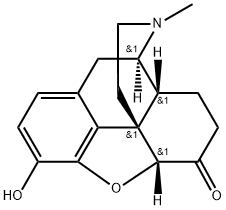Hydromorphone (Item No. 15463) is an analytical reference material categorized as an opioid. It is a metabolite of morphine (Item Nos. 15464 | ISO60147). Like other opioid analgesics, hydromorphone is commonly abused. Hydromorphone is regulated as a Schedule II compound in the United States. This product is intended for research and forensic applications.
Meperidine (pethidine) is available as parenteral and oral preparations.
There is no evidence that this opioid provides any advantage over morphine,
such as treatment of colicky-type pain. Its analgesic action is fairly short, but
the metabolite normeperidine can accumulate (t1/2 ~ 15h) if repeated doses
are given and especially if there is renal dysfunction. Normeperidine is a
CNS stimulant and can cause seizures. Its clearance is significantly reduced
in hepatic disease. Chronic use may result in enzyme induction and an
increase in normeperidine plasma concentrations. Its metabolism is
decreased by the oral contraceptive pill.
Meperidine has other significant effects related to activity at non-opioid
receptors. For example, its atropine-like action may cause a tachycardia, in
addition to direct myocardial depression at high doses. It was used originally
as a bronchodilator. It can also reduce shivering related to hypothermia or
epidural anaesthesia, although the mechanism for this is not fully
understood. Meperidine also has a local anaesthetic-like membrane
stabilising action.
Hydromorphone, a potent opioid, is used mainly in the palliative care seing
or in patients who are not opioid naive. It can be useful if considering opioid
rotation. Hydromorphone 1.3mg is approximately equianalgesic to morphine
10 mg. Both immediate- and sustained-release preparations are available.
ChEBI: A morphinane alkaloid that is a hydrogenated ketone derivative of morphine. A semi-synthetic drug, it is a centrally acting pain medication of the opioid class.
Hydromorphone is eight times as potent as morphine
but has less bioavailability following oral administration.
Its side effects do not differ from those of morphine
but are more intense. Hydromorphone is
indicated for use in severe pain and in high doses for relief
of pain in opioid-addicted patients.
Hydromorphone, (Dilaudid) is a synthetic derivative ofmorphine prepared by the catalytic hydrogenation and dehydrogenationof morphine under acidic conditions, using alarge excess of platinum or palladium. Oxidation of the 6-OH of morphine resulted in a compound with decreased potency.Reducing the 7,8 double bond of morphine increasedthe flexibility of the molecule and resulted in a compoundwith slightly enhanced binding. Making both of these structuralchanges to morphine-produced hydromorphone, acompound approximately 5 times as potent as morphine.Hydromorphone was introduced in 1926 and is available as animmediate release tablet, a liquid, and a suppository. A sustainedrelease form is available in some countries but not inthe United States. The sustained release form was removedfrom the U.S. market in 2005 when studies showed that drinking8 oz of alcohol (40%) could cause the drug to be releasedfrom the capsule immediately and lead to concentrations thatwere 5.5 times higher than in patients that did not drink alcohol.This potentially lethal combination prompted the Foodand Drug Administration (FDA) to remove it from the market.

